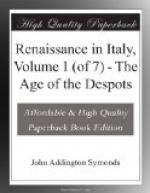But while recognizing these differences, which manifest themselves partly in what may be described as national characteristics, and partly in constitutional varieties, we may trace one course of historical progression in all except Venice. This is what natural philosophers might call the morphology of Italian commonwealths. To begin with, the Italian republics were all municipalities. That is, like the Greek states, they consisted of a small body of burghers, who alone had the privileges of government, together with a larger population, who, though they paid taxes and shared the commercial and social advantages of the city had no voice in its administration. Citizenship was hereditary in those families by whom it had been once acquired, each republic having its own criterion of the right, and guarding it jealously against the encroachments of non-qualified persons. In Florence, for example, the burgher must belong to one of the Arts.[1] In Venice his name must be inscribed upon the Golden Book. The rivalries to which this system of municipal government gave rise were a chief source of internal weakness to the commonwealths. Nor did the burghers see far enough or philosophically enough to recruit their numbers by a continuous admission of new members from the wealthy but unfranchised citizens.[2] This alone could have saved them from the death by dwindling and decay to which they were exposed. The Italian conception of citizenship may be set forth in the words of one of their acutest critics, Donato Giannotti, who writes concerning the electors in a state:[3] ’Non dico tutti gli abitanti della terra, ma tutti quelli che hanno grado; cioe che hanno acquistato, o eglino o gli antichi loro, faculta d’ottenere i magistrate; e in somma che sono participes imperandi et parendi.’ No Italian had any notion of representative government in our sense of the term. The problem was always how to put the administration of the state most conveniently into the hands of the fittest among those who were qualified as burghers, and how to give each burgher his due share in the government; not how to select men delegated from the whole population. The wisest among their philosophical politicians sought to establish a mixed constitution, which should combine the advantages of principality, aristocracy, and democracy.




